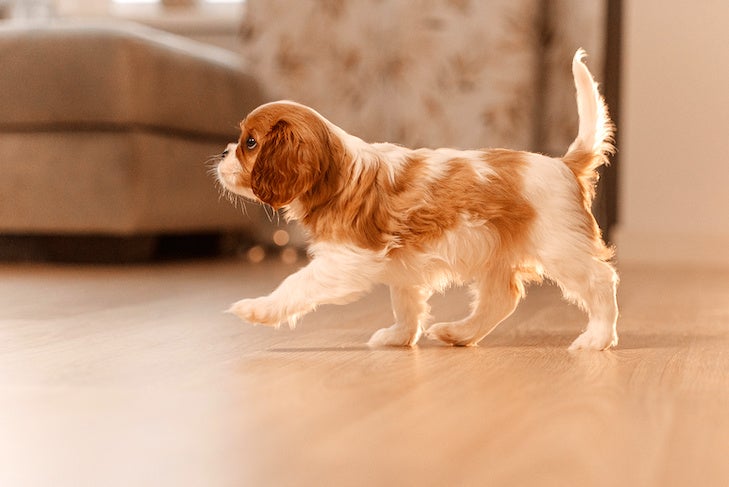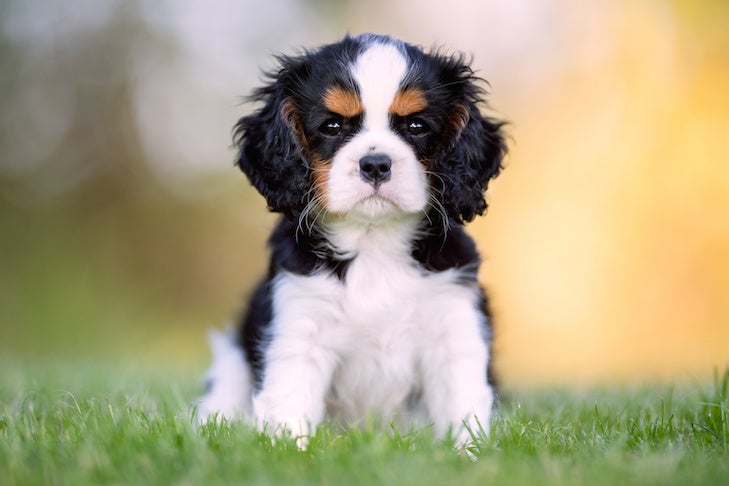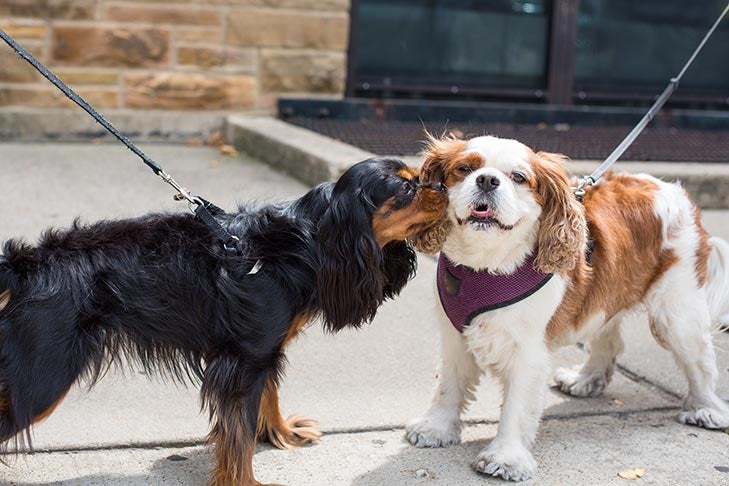Preparing the sweet, gentle Cavalier King Charles Spaniel to follow good behavior guidelines isn’t tricky. This graceful, fun-loving toy spaniel only wants to please you. With some planning, persistence, and a positive outlook, your puppy quickly takes to training.
Sandy Harrison, Recording Secretary of the American Cavalier King Charles Spaniel Club, acquired her first Cavalier in 2000. The former Cocker Spaniel (Parti-Color) and Pug breeder fell in love with the breed’s beauty and easy-going temperament.
As a breeder, owner, and conformation handler, she recommends setting up the following goals at certain times in your puppy’s development.
Key Milestones: Birth-6 Weeks
Cavalier training begins in the whelping box. Before your puppy comes home, the breeder should provide a few basic lessons.
Training Goal #1: Early Socialization with the Breeder
“When breeders begin handling their puppies daily from birth, they give them a good start,” says Harrison. “From day 3, Early Neurological Stimulation helps the pups take strange situations in stride later in life.”
At three weeks, the puppies can go into a crate while the breeder cleans the whelping pen.
“At five weeks, the puppies are ready to spend an hour in individual crates,” says Harrison. “This helps them learn that separating from their litter is not something to be upset about and helps with early housetraining.”
By six weeks, the breeder can begin inviting adults and well-behaved children to meet the puppies. Before entering the kennel area, guests should leave their shoes at the door and use hand sanitizer. Harrison asks visitors to bring a change of clean clothes. This avoids transmitting Parvo, a deadly virus.
The critical socialization period begins at 3 weeks and ends at 12 weeks. This time is crucial for a dog’s behavioral development and puppies should experience positive interactions with their littermates, people, noises, and sounds. The early exposure helps reduce unwanted behaviors later.
Remaining with their mother, littermates, and the breeder’s other dogs until the pups are 11 to 12 weeks old helps them build their social skills.

Key Milestones: 7-10 Weeks
The breeder introduces a few basic skills to set your pup up for later success.
Training Goal #2: Begin Leash, Potty, and Groom Training
“At seven and eight weeks, I put collars on puppies and supervise a session with one pup dragging a leash around, but I don’t leave the leash on all the time,” says Harrison. “When the other pups pull on the leash, it simulates leash walking.”
To introduce housetraining, the breeder takes pups outside to potty after a nap, after a meal, and during playtime.
One to two weeks later, the breeder bathes the puppy, puts it on a grooming table for light brushing, and offers a treat. At another session, the breeder will clip the puppies’ nails.
Key Milestones: 10-12 Weeks
Your puppy comes home. Starting off on the right paw.
Training Goal #3: Prepare for Your Cavalier’s Arrival and Manage Your Expectations
Before your puppy comes home, stock up on the pet supplies you’ll need. Having them on hand gives you more time to spend with your pup.
Set up a room where the puppy can play and rest without getting into trouble. Use baby gates or room dividers to create a boundary.
Create a daily schedule for feeding, housetraining, sleeping, and playing. You can modify the timetable later. Following consistently helps your puppy learn what you expect.
To help build a bond with your new pup, think about staying home the first day. Give your pup a day or two to settle into the new surroundings before inviting a lot of visitors for a meet and greet.
Training Goal #4: Set Your Training Goals
What basic manners do you want your puppy to learn?
Housetraining usually ranks at the top of the list, while sleeping quietly through the night, crate training, and appropriate chewing follow close behind.
“Most owners also want to discourage begging at the table, jumping at guests, and pulling at the leash,” says Gail Katz, Performance Chair of the American Cavalier King Charles Club. “Cavaliers want to please you, so teaching your pup to focus on you makes all training easier.”
Katz suggests keeping training lessons short—about 5 to 10 minutes, using treats as a lure and as a reward, and praising rather than punishing.

Key Milestones: 3-4 Months
At this age, Cavaliers are eager to learn.
Training Goal #5: Introduce Your Cavalier to Bathing, Brushing, Nail, Ear, and Oral Care
Cavaliers require regular grooming and professional dental cleaning. When you begin the routine early in life, they learn to accept and enjoy the pampering.
Training Goal #6: Walking on Leash
“Keep a loose leash and use food to lure them to follow you,” says Katz.
Training Goal #7: Socializing Your Puppy with People and Places
Until your puppy is fully vaccinated, use a pet stroller on outings to introduce your Cavalier to new sights, sounds, and people.
Training Goal #8: Sign Up for Puppy Kindergarten
This class gives your puppy the opportunity to meet other dogs and people in a safe place. Choose a small class with up to six puppies younger than 16 weeks. If you don’t feel comfortable taking your puppy out to a public location, ask a trainer to come to your home and invite other puppy owners.
- Sit
- Down
- Stay
- Come
- Wait
Training Goal #10: Tricks are Fun
Cavaliers are natural clowns at learning tricks. With a little practice and food treats as rewards, shake a paw, rollover, and spin in a circle, are easy to master.

Key Milestones: 9 Months-1 Year
Cavaliers form strong attachments to their people and often dislike separation. Getting them engaged in other activities outside the home builds their confidence.
Training Goal #10: Introduce Performance Sports
Some owners recommend taking their Cavaliers to obedience classes, while others prefer bringing in a private trainer.
Gail Katz strongly recommends taking a Cavalier for daily walks and passing the Canine Good Citizen Test.
“AKC Rally, AKC Agility, AKC FastCat, scent work, and barn hunt, are great outlets for Cavaliers,” says Katz. “They love to have fun and work to please you.”
Training Goal #11: Training for Therapy Work
Many Cavaliers love nothing better than snuggling on a bed with a hospital patient.
“This breed excels at comforting others,” says Katz.

